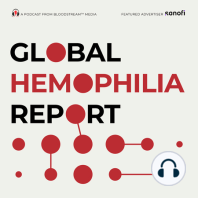41 min listen

Hemophilia Gene Therapy Redux – The End of the Beginning?
Hemophilia Gene Therapy Redux – The End of the Beginning?
ratings:
Length:
61 minutes
Released:
Jan 25, 2024
Format:
Podcast episode
Description
Gene therapy for hemophilia A and B now exists as a licensed, prescribable treatment option for patients in certain countries; however, many questions and challenges remain. Senior advisor Dr. Donna DiMichele and patient-host Patrick James Lynch speak to global KOLs about the current state of hemophilia A and B gene therapies, both commercially and investigationally. Contributors: Lindsey A. George, MD Margareth Ozelo, MD Steven Pipe, MD Senior Advisor: Donna DiMichele, MD Hosted & Written by: Patrick James Lynch Featured Advertiser: Sanofi Subscribe to the Global Hemophilia Report Notes and References: Nathwani: Hematology Am Soc Hematol Educ Program . 2022 Dec 9;2022(1):569-578. The current state of this exciting and rapidly evolving field, as well as the challenges that need to be overcome for the widespread adaptation of this new treatment paradigm, is the subject of this review. Pipe: N Engl J Med. 2023 Feb 23;388(8):706-718 The annualized bleeding rate decreased from 4.19 (95% confidence interval [CI], 3.22 to 5.45) during the lead-in period to 1.51 (95% CI, 0.81 to 2.82) during months 7 through 18 after treatment, for a rate ratio of 0.36 (95% Wald CI, 0.20 to 0.64; P<0.001), demonstrating noninferiority and superiority of etranacogene dezaparvovec as compared with factor IX prophylaxis. Factor IX activity had increased from baseline by a least-squares mean of 36.2 percentage points (95% CI, 31.4 to 41.0) at 6 months and 34.3 percentage points (95% CI, 29.5 to 39.1) at 18 months after treatment, and usage of factor IX concentrate decreased by a mean of 248,825 IU per year per participant in the post-treatment period (P<0.001 for all three comparisons). Benefits and safety were observed in participants with predose AAV5 neutralizing antibody titers of less than 700. No treatment-related serious adverse events occurred. Long-Term Effects of Hemophilia B Gene Therapy. Makris M.N Engl J Med. 2023 May 18;388(20):1918. Long-Term Effects of Hemophilia B Gene Therapy. Reply. Pipe SW, Monahan PE.N Engl J Med. 2023 May 18;388(20):1918-1919 Mahlangu: N Engl J Med. 2023 Feb 23;388(8):694-705 Results: At week 104, a total of 132 participants, including 112 with data that were prospectively collected at baseline, remained in the study. The mean annualized treated bleeding rate decreased by 84.5% from baseline (P<0.001) among the participants. From week 76 onward, the trajectory of the transgene-derived factor VIII activity showed first-order elimination kinetics; the model-estimated typical half-life of the transgene-derived factor VIII production system was 123 weeks (95% confidence interval, 84 to 232). The risk of joint bleeding was estimated among the trial participants; at a transgene-derived factor VIII level of 5 IU per deciliter measured with chromogenic assay, we expected that participants would have 1.0 episode of joint bleeding per year. At 2 years post infusion, no new safety signals had emerged and no new serious adverse events related to treatment had occurred Miesbach : Dtsch Arztebl Int. 2022 Dec 27;119(51-52):887-894. Data from non-randomized phase 1 to phase 3 trials reveal an adequate expression of factors VIII and IX in patients with mostly severe hemophilia A or B. Even though they were no longer receiving prophylactic treatment, most patients experienced a considerable reduction, by 53% to 96%, in the number of bleedings compared to previous therapy. Persistently elevated factor levels have been described for up to six years in hemophilia A and up to eight years in hemophilia B. The most common side effect of gene therapy is an inflammatory response with elevated alanine aminotransferase levels (17% to 89%, depending on the study), which may be associated with a reduced clotting factor level and requires treatment with transient immunosuppression. Gene therapy for hemophilia holds out the prospect of freedom from hemorrhage without the need for regular treatment with drugs. The v
Released:
Jan 25, 2024
Format:
Podcast episode
Titles in the series (29)
Inhibitors: Prevention, Eradication, and Lived Experiences: Inhibitor development has long been considered the most significant complication of severe hemophilia, but with the licensure of the first non-factor therapy and a robust pipeline of novel and gene therapeutics being investigated, is it still of... by Global Hemophilia Report